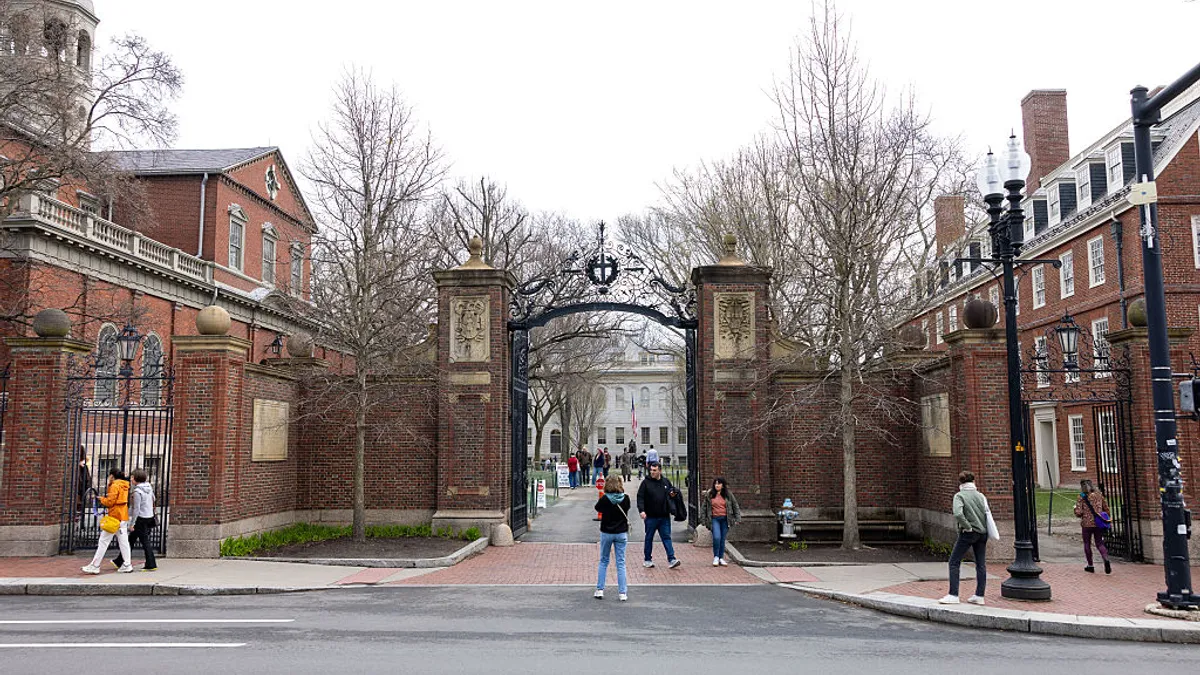Like any other industry, higher education has its haves and its have-nots.
Often falling on the have-not side are regional colleges, loosely defined as four-year public schools that aren't flagship or research institutions. Though regional colleges outnumber their flagship counterparts, they generally serve higher shares of disadvantaged students while receiving less in state and federal support.
A new report from the Brookings Institution, a Washington, D.C.-based think tank, argues this should change. Its authors developed a proposal for regional schools specifically in economically challenged areas.
They say the federal government could designate these colleges "distressed-community-serving institutions" and give them grants worth between $25 million and $50 million, paid out over five years. The report identifies more than 140 four-year institutions in the U.S. and Puerto Rico as candidates for the funding.
With the grant money, these schools could invest in digital infrastructure such as broadband. They could "improve university and community capacity to address regional public health or economic challenges," the report states. Or they could help scale up business development.
Higher Ed Dive talked with one of the report's authors, Robert Maxim, a senior research associate at Brookings, about his vision for the proposal, the barriers still facing regional colleges and how to sell the idea of new federal support to policymakers.
Editor's note: This interview has been edited for brevity and clarity.
HIGHER ED DIVE: How was this idea of federal assistance for regional colleges born?
ROBERT MAXIM: We've been looking at this idea of distressed communities for several years. Our view as individual scholars is that the last two to three economic recoveries have been spatially unequal. There's a lot of discussion about interpersonal inequality — the pull away of the superrich from the middle class. But the idea of spatial inequality is important as well — the pull away of the richest, most successful areas from the rest of the country. Think of your San Francisco, Seattle, Boston, in particular the tech industry-driven metro areas.
So there was a lot of research coming out about the effect of research universities in creating new tech hubs across the U.S., about how anchor institutions can develop regional cluster strategies, things like that. We, as a team, were unsatisfied with the discussion ending there. Our view was there was a gap in the literature around regional public universities.
There was a fair amount of conversation around community colleges, too. And at least within the Democratic party, there was a growing consensus that these institutions should have an unquestioned level of federal baseline support. But we saw a gap, and that was those smaller four-year schools. There was a research gap, and the policy environment hadn't caught up.
There are way more regional public universities in the U.S. than there are bigger R-1s. Our view is that they are really good anchor institutions to route federal investment through. They are a set of institutions that have been historically neglected and deserve a bit more attention and support from the federal government.
These institutions are worthy of study and could potentially be a powerful vehicle for supporting distressed places.
Why haven't these colleges gotten as much attention?
They're just not as high-profile as other schools. That can be a problem when it comes to things like the ability to garner public support for more investment. They tend to have smaller budgets for federal and state policy outreach compared to flagship and research institutions.
Higher education has also been used to balance state budgets. Many states have constitutionally mandated investments that they need to make, K-12 being a big one. In periods of disinvestment, higher ed ends up being the thing that gets cut, and then it becomes not much of a priority for states. The schools that suffer the most from state disinvestment are regional publics because they don't have the resources to jack up tuition or attract a ton of foreign or out-of-state students.
There's also a bit of a bias in policy organizations themselves. There's underrepresentation in policy groups and think tanks, those crafting higher education policy, who went to regional public universities. A lot of them tend to recruit from elite schools or expensive private schools.
And there's definitely a vein of anti-higher education sentiment in U.S. politics right now. I'm not talking about outright malice, but when policymakers think about what to prioritize on a state or federal budget level, higher ed institutions and regional schools tend to fall by the wayside.
Did the pandemic draw attention to the benefits of these types of schools or highlight their financial weaknesses?
It definitely drew attention to them, but I also think it created an unfair narrative that all of these schools are in financial crisis. People were asking, "Are they going to go extinct? If so, what's the point of having them?"
That's a harmful narrative. There was a little bit of over-rotation where people thought that more universities would go under than did. And there was some conflation of less high-profile public universities with small private liberal arts colleges, painting them all with a broad brush that they would close. But these are universities with totally different financial situations because they're public.
There are positive benefits because more articles are being written about them now. People know about them, and I think there's more research that will go into them. The downside is that the one narrative that made it into the general public and policy sphere was these schools were all in crisis, and that's not true. Some of them are facing severe financial challenges, but others are doing fine. We try to make that distinction in our piece. A school that is in a distressed community may not be distressed financially.
A logical leap is that some of these schools are in bad financial condition and need to close because of their mismanagement. To me, it's more that these schools are not doing well financially in large part because of state funding decisions, or tuition and enrollment mandates.
What would the effect be on a community if these schools were to consolidate or close?
Place-bound students who we need to go back to school would be most affected. Their main source of affordable postsecondary education would be closing.
There will be fewer 18- to 22-year-olds every year for a while, and it will take time for the sector to recover. The only way you get more of the workforce to have a postsecondary credential is for adult learners to return to school.
There may be community colleges in the area, but they mostly only offer two-year degrees. Private colleges are also just more expensive. Also, underrepresented students, typically students of color, lower-income students, tend to attend regional public universities disproportionately. These are all groups that are in the margins of higher education to begin with.
That's not even talking about the economic effects, the job losses when you have such an anchor institution closing. Many places saw this with manufacturing and coal declines when they were the largest employers in an area and closed. I have to imagine the magnitude would be similar if you outright close a campus.
What kind of initiatives do you envision the federal grants benefiting?
Closing the broadband divide is a huge one. It's not just laying fiber in rural areas. The broadband discussion has been disproportionately focused on rural areas that don't have access to the internet whatsoever. And it's true that we need to service them. At the same time, many urban-located families in the U.S. find internet unaffordable or inaccessible. These schools — and this is where public mission is important — can help find affordable ways to expand internet access for families and students and be actors in the community.
Another is improving local school districts. When you talk about factors that lead to economic distress, my view is that they emerge early in life, in terms of a lack of opportunities individuals have. The effects of lower-quality school districts ripple out throughout students' entire lives.
Having an educated and productive local human capital stock starts with pre-K and K-12 investment.
Third is trying to capture the benefits of agglomeration. You see so many places offering massive economic development subsidies for companies to move there. If you create a cluster there, it tends to have powerful economic effects if you do it right. It doesn't always get done right. Regional public universities can be important incubators and entrepreneurship-support organizations.
How do you sell the idea of federal support for regionals to policymakers?
When I talk to policymakers, I emphasize the broad presence of these schools. We did the math, and it's like, 34 states, nearly 100 congressional districts have at least one of these schools in them. And that's just the distressed community-serving institutions we identified. I would hope policymakers looking to do what is best for the economic community development of the places they represent would recognize that these are an asset.
Just emphasizing also that this is nonpartisan can help. Economic and community development is the bread and butter of what Congress or state policymakers are setting out to do.
Distressed communities aren't going away anytime soon. If Congress chooses not to invest, this will remain a relevant issue for a while and moving forward. We're hoping that something gets done sooner rather than later, but we also are kind of realistic and doing this as a bit of a long game.





















